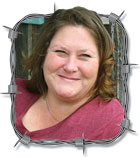It’s Dairy Month! Time to salute the dairy farmers of the Ozarks and their herds.
There’s a lot of milk drank and cheese eaten at my house, so we are fans of the industry.
Even my big ol’ dog is a cheese nut. We have to spell out “cheese” because Nell knows what the word means and will start spinning around like a top, hoping she will get a treat. Nell and Bill go through a lot of block cheese. When Bill comes in from the shop most afternoons, he will break out a block for a mid-afternoon snack. His buddy is right there beside him, waiting for a few slices of heaven. When she has to take a pill, I ask her, “Do you want some cheese, please?” The drooling starts, and the cheese and pill are gone.
I have always had a love for the dairy industry. A part of me wants to be a full-time dairy farmer, and I’m a little jealous of those folks who are. I’m sure they will all say there’s nothing to be jealous of, but I am.
I’m like most cattle breeds, but there’s just something about those dairy ladies that make me double-take.
On a recent farm visit, a couple of dairy heifers decided they liked me — a lot. One kept licking me, rubbing her head on me and chewing on my shirt; she wasn’t a baby calf either. She wasn’t the only heifer to want some attention, and I was covered in slobber. Just a perk of working at Ozarks Farm & Neighbor some days. The owners said they wanted docile and friendly animals, but some of their girls were almost too friendly. I will take that kind of friendly over an aggressive animal anytime.
I’m impressed by dairy goats. For small animals, dairy does put out a lot of milk. There is a growing demand for goat milk products in the Ozarks. Some people can digest goat milk but can’t tolerate cow milk. Goat milk is also versatile. It can also be used to raise orphaned animals, including calves and foals, or in soap, lotion or hair products.
Just like cattle dairies, goat dairy producers breed for the highest-quality animal possible, and I have met some exceptional dairy goat producers. One of the first stories I did when I came to OFN was about a registered LaMancha breeder. If you don’t know what a LaMancha looks like, a quick internet search will show you what sets this breed apart from others.
Not too long ago, a dairy farm near me sold out. It was hard to imagine driving by this farm and not seeing those cows anymore, but the fields and barns are empty. Decades of selective genetic development went into the herd, and they are now gone. I had a couple of heifers from there when I was a kid.
Dairy herd dispersal sales, unfortunately, are getting to be the norm.
According to the Feb. 27, 2023, edition Hoard’s Dairyman, 6.4 percent of all U.S. dairy farms holding permits to sell milk left the industry in 2022. Of states having more than 1,000 dairy farms, Missouri took the hardest hit with a loss of 13.8 percent.
There is some good news, however, when it comes to the nation’s dairy industry.
Dairy consumption is on the rise, with the growth being in American-type cheese, butter and yogurt. The Michigan Farm Bureau has reported the value of U.S. dairy exports jumped 25 percent to $9.5 billion in 2022. Not too shabby.
Let’s all support our local dairy farmers during Dairy Month, and share the good news about the dairy industry in the Ozarks. Pick up your favorite dairy product at your local retailer. If you know someone selling dairy products off their farm, check them out and see if they have something you might like to try.
Share with your friends and neighbors that milk and dairy products are rich in calcium, vitamin D and phosphorus, which help with bone building, and the high potassium content of dairy foods can help lower blood pressure.
To all my friends in the dairy industry, Nell and Bill thank you for their afternoon snacks, and I thank you for being a dairy farmer.
Julie Turner-Crawford is a native of Dallas County, Mo., where she grew up on her family’s farm. She is a graduate of Missouri State University. To contact Julie, call 1-866-532-1960 or by email at [email protected].







